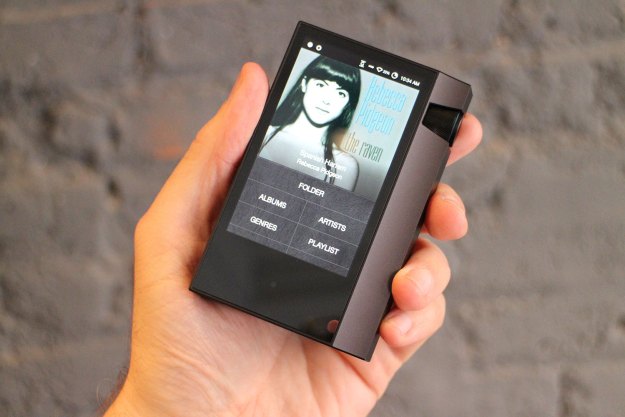
“More audio technology inside for only a little more money makes the Astell & Kern AK70 MK II exactly the kind of upgrade we love.”
- Stylish, instantly recognizable design
- Strong musical performance, especially for vocals
- Doubles as a headphone DAC
- More powerful balanced headphone out
- AptX HD
- Operating system can be slow
Two is always better than one, right? When you’re Astell & Kern it certainly is, as demonstrated by the new AK70 MK II music player, which has dual Cirrus Logic CS4398 digital-to-analog converter (DAC) chips inside, instead of the single one used in the previous model. Not that you’d know just from looking at the player, as the same eye-catching, hewn-from-a-solid-metal-block look has been retained. In our AK70 MK II hands-on review, we find out if doubling the DAC chipsets means the player delivers double the audio pleasure.
The look
Let’s talk about design and feel first. Smartphones, which have become the go-to music player for most, have increasingly grown in size over the past few years. The Astell & Kern AK70 MK II is much more compact, and easily fits in the palm of your hand, or slips in your pocket. It’s not a tiny sliver of a thing that’ll fall out of your hand like the last generation Apple iPod, Sony’s NW-ZX300, or even Astell & Kern’s own AK Jr, though. There’s genuine heft and thickness from the anodized duralumin body, which weighs 150 grams; but instead of being off-putting, it feels high quality, expensive, and reassuringly well made.
A 3.3-inch AMOLED screen shows the custom, Google Android-based operating system. It’ll be familiar to anyone coming from a phone, with swipes, taps, and gestures controlling the main functions. However, the OS lacks the responsiveness one expects from a modern Android phone, and some of the buttons are tiny on the small screen, which means there is potential for it to be frustrating to use on the move. It looks wonderful though, with the deep blacks and high contrast colors we expect from an AMOLED display shining through.
The oversize volume control on the side looks great, adding visual punch to the player, and while it requires lots of twists to dramatically increase the volume, this is by design: Unlike phones that present broad changes between volume levels, Astell & Kern’s players offer a higher level of control so you can dial in the sound just right. That said, it’s easier – and faster — to swipe up and down on the touchscreen for volume control.
Otherwise, the buttons are all easy to reach, and it’s obvious what they do. We’re less likely to constantly interact with the AK70 MK II than we are a phone, so the minor interface sluggishness will be just that — minor.
Vocal superiority
We only had a small selection of demo tracks to try after plugging in our headphones — for our demo, we used our trusty pair of B&O Play H2 on-ears — but there was enough variety to give us a strong impression. It’s instantly obvious just how much the AK70 MK II loves to sing. Vocal tracks soar and beguile, demonstrating the AK70 MK II’s rich tuning. Rebecca Pidgeon’s Spanish Harlem was utterly involving, and wonderfully intimate.
Doubling the DAC chipsets means double the audio pleasure.
The strummed bass line never overpowered the singer’s sweet voice, and it made us smile all the way through — which ultimately, is what quality sound should do. It’s very easy to fall for the AK70 MK II when it facilitates these emotions. This isn’t to say non-vocal tracks suffer. Duke Ellington’s In A Mellow Tone was detailed and lively, while the stereo separation at the start of David Bowie’s Starman was precise and fun.
Listening to music on a device dedicated to doing so is an eye-opening experience. Smartphones can sound great — the LG G6 and LG V30 spring to mind — but can’t deliver the same power, versatility, or musical energy as the AK70 MK II. It plays most major file types, from MP3 to FLAC, and in 24bit/192KHz resolution, while DSD files will be converted to PCM. The player offers 64GB of storage, with 256GB more available via an SD slot. Upgraded circuitry means improved signal-to-noise ratio, crosstalk, and reduced jitter over the AK70 MK 1. Onboard Wi-Fi lets you connect to streaming music services, and the good news is the player has AptX HD support through the Bluetooth connection.
The AK70 MK II also has a larger battery than the original, though Astell & Kern tells us this mostly gets eaten up by the second DAC chipset, making the upgrade a wash. Battery playback is estimated between 6-8 hours per charge. In addition to the regular 3.5mm headphone jack, a more powerful 2.5mm balanced output — almost doubling the MK I player’s 2.3Vrms output to 4.0Vrms — is alongside it, ready to drive more capable, demanding
Doubling the technology hasn’t given Astell & Kern reason to double the price. The AK70 MK II is $700, up $100 from the AK70 MK 1, which although pricey when your smartphone will play at least some of the music files with moderate results, is excellent value when you consider this is the first A&K music player to include dual-DACs below the $1,000 price point.
Whether it’s worth that level of financial investment will come down to your love of music and depth of wallet. However, as storage space and battery life on smartphones becomes more of a concern, and availability of high-quality music becomes greater, owning a dedicated music player is making more sense every day. We’d recommend testing the versatile, great sounding, and eye-catchingly styled Astell & Kern AK70 MK II if this predicament sounds familiar.









